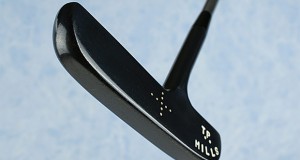 In earlier stories, we tackled the topic of belly putter fitting from the vantages of putter length and putter balance.
In earlier stories, we tackled the topic of belly putter fitting from the vantages of putter length and putter balance.
We now turn our attention to another key factor in belly putter fitting: head weight.
Belly putters typically come with heavier head weights than their traditional counterparts. Indeed, it’s not uncommon for a belly putter’s head to weigh 50 or more grams than its standard-length counterpart.
However, this can seem counterintuitive, because with a traditional putter, you typically lighten the head weight as you lengthen the shaft to maintain a controllable swingweight.
For added insight into this topic, we consulted an expert on heavier head weights: Stephen Boccieri, creator of the Heavy Putter. He explained that the swingweight dynamic of a belly putter is different because of the force required to anchor it.
“Because a belly putter is anchored to your body, you create an upward force on your body to maintain the connection,” Boccieri says. “This force is more than a normal putter, and in itself will make the putter feel lighter. Without adding more weight to the putter, the element becomes very unstable. A good way to better understand this is to take a shaft without a head and hold it up against you body and watch how it is almost impossible to make a stroke without the shaft going into a rotational tailspin.”
Boccieri also noted that belly putters come with a heavier grip and shaft for enhanced counterweighting.
“It’s not only head weight that helps the situation,” he says. “It is the combination of additional head weight, a heavier ski pole shaft, and a belly putter 21-inch grip of typically 130-plus grams that adds to the overall weight and overcomes the upward force phenomena. In the case of the Heavy Putter Belly Putter, we add a backweight which adds even more weight and promotes more stability.”
According to Boccieri, the belly putter phenomenon is opening golfers’ eyes in terms of exploring alternative concepts such as the Heavy Putter, even if they decided to stick to a traditional length.
“We are looking at a very interesting opportunity for Heavy Putter this year, in that many golfers are looking to try something different to improve their putting,” he says. “Opening the door to try something is a great way for us to introduce our belly putter, but at the same time it allows us to show golfers that they can get the same stability as a belly just by using our conventional length Heavy Putter and they don’t have to learn a whole new putting technique.”
 PutterZone – Best Putter Reviews
PutterZone – Best Putter Reviews



